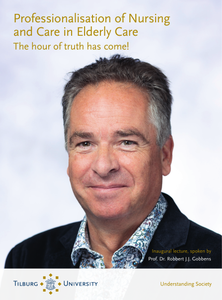In a matter of weeks last year, discussions regarding tourism in cities changed from how to deal with overtourism to how to deal with ‘no tourism’. Shortly thereafter, a great number of posts on LinkedIn, websites, and blogs highlighted how the tourism crisis that resulted from the COVID-19 pandemic could help reinvent tourism, into something more equal, inclusive, and sustainable. And so, online – at leastin mypersonalonlinebubble – there seemedtobe a real momentum for proper, transformative changes in (urban) tourism. How can we rebuild urban tourism in a sustainable and resilient way?
DOCUMENT

Inaugural lecture, delivered upon public acceptance of the endowed professorship in Professionalisation of Nursing and Care in Elderly Care by Prof. Dr. Robbert J.J. Gobbens at Tilburg University on 29 September 2023.
DOCUMENT

A year later, in 2013, the Westerkwartier Area Cooperative was established – a new form of cooperation at the regional level, involving hundreds of dairy farmers, other SMEs, Terra MBO as the representative of the knowledge institutions in the region, the National Forest Service in the Netherlands (‘Staatsbosbeheer’), the Groningen Countryside Association (‘Landschapsbeheer Groningen’) and, later on, the De Zijlen healthcare institution. A year later, this initiative was followed by the establishment of the Southwest Drenthe Area Cooperative, another formalised multi-stakeholder cooperative on a large scale, bound together by a shared agenda. The members of these two new cooperatives sought to bring together and strengthen local and sectoral initiatives at the regional level. Because of their close cooperation with knowledge institutions, they hoped that practice-based research would yield a lot of results. At the many evening meetings and during workshops, spirited debates were held about new concepts such as bio-based economy, new concepts in food and health, alternative methods of energy production, but also ways of improving the quality of life in the region, strengthening the tourism industry and creating jobs for young people. Those involved were all too aware that the existing educational and research institutes and government agencies, and the organisational structures used by businesses, tend to do more harm than good, which led to the call for Next Education, Next Governance and Next Business. It became apparent from these discussions that there were many knowledge questions to be explored, and the need arose for a permanent link with the knowledge institutions through the establishment of a separate professorship focused on sustainable and cooperative entrepreneurship for the benefit of the entrepreneurs involved as well as for the education sector, the government and the general public. This is how the Sustainable Cooperative Entrepreneurship professorship came about, as part of the Sustainable Financial Management professorship chaired by Dr Margreet Boersma at Hanze University of Applied Sciences Groningen’s School of Financial and Economic Management. I am honoured to be giving this new professorship shape, and I would like to point out that I will not be doing this on my own – I am only the figurehead of a very substantial group of innovative and ambitious entrepreneurs, students, lecturers, public servants, citizens and colleagues. The Innovation Army is marching. And if you are not a part of it yet, now is the time to get involved!
DOCUMENT